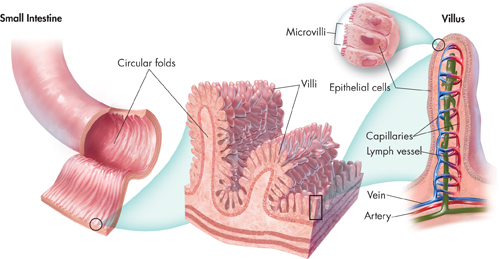Absorption and Elimination
 How are nutrients absorbed and wastes eliminated?
How are nutrients absorbed and wastes eliminated?
Once the small intestine has completed the digestive process, nutrients must be absorbed from the alimentary canal.  Most nutrients from food are absorbed through the walls of the small intestine. The large intestine absorbs water and several vitamins and prepares waste for elimination from the body.
Most nutrients from food are absorbed through the walls of the small intestine. The large intestine absorbs water and several vitamins and prepares waste for elimination from the body.
Absorption From the Small Intestine After leaving the duodenum, chyme moves along the rest of the small intestine. By this time, most of the chemical digestion has been completed. The chyme is now a rich mixture of small- and medium-sized nutrient molecules that are ready to be absorbed.
The small intestine is specially adapted for absorption of nutrients. Its folded surface and fingerlike projections provide an enormous surface area for absorption of nutrient molecules. The fingerlike projections, called villi (singular: villus), are covered with tiny projections known as microvilli. As slow, wavelike contractions move the chyme along the surface, microvilli absorb nutrients. Figure 30–16 illustrates villi and microvilli.
Nutrient molecules are rapidly absorbed into the cells lining the small intestine. Most of the products of carbohydrate and protein digestion are absorbed into the capillaries in the villi. Most fats and fatty acids are absorbed by lymph vessels.
By the time chyme is ready to leave the small intestine, it is basically nutrient-free. Complex organic molecules have been digested and absorbed, leaving only water, cellulose, and other undigestible substances behind.
ZOOMING IN
ABSORPTION IN THE SMALL INTESTINE

FIGURE 30–16 The lining of the small intestine consists of folds that are covered with tiny projections called villi. Within each villus there is a network of blood capillaries and lymph vessels that absorb and carry away nutrients.
dTable of Contents
- Formulas and Equations
- Applying Formulas and Equations
- Mean, Median, and Mode
- Estimation
- Using Measurements in Calculations
- Effects of Measurement Errors
- Accuracy
- Precision
- Comparing Accuracy and Precision
- Significant Figures
- Calculating With Significant Figures
- Scientific Notation
- Calculating With Scientific Notation
- Dimensional Analysis
- Applying Dimensional Analysis




